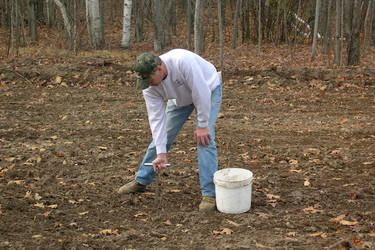Soil Testing- The First Step to a Quality Food Plot
Posted by Rod Ellwanger on 28th Mar 2017
Soil testing your food plots is one of the most important
things you can do to assure a successful plot. The results obtained from the
Soil Test Report will tell you the pH (level of soil acidity), organic matter
content, phosphorus and potassium levels of the soil. This valuable information
will help you decide what to apply for lime and fertilizer based on the crops
to be planted. It will also help you decide what crops to plant in various
fields as some crops are more pH sensitive than others. Most soils in forested
areas where food plots are created will be somewhat acidic with a lower pH
reading.
Soil pH is the single most important factor influencing if nutrients in the
soil will be available to a growing plant. A soil pH of 7.0 is considered
neutral and is ideal for growing many agricultural crops such as alfalfa, while
a soil pH of 6.0 or higher is considered adequate for growing most food plot
crops. A soil with a pH of 5.0 is 10 times more acidic than a soil with a pH of
6.0, and many of the nutrients contained in the soil will be “tied up” and not
be available to the crops growing in them. Raising the soil pH makes the soil
less acidic, releasing more nutrients allowing them to be available to a
growing crop. Other benefits include improved bacterial activity and nitrogen
fixation by legumes along with improved physical soil properties.
Spreading lime on the surface of your plots and tilling it into the soil is the
best way to correct a low pH. Whether lime is referred to as aglime, barn lime,
high calcium lime, pel-lime, or something else, there is little difference in
the ability of the liming material to correct the pH of the soil. Particle size
will vary and affects how fast the material will be dissolved in the soil
solution. A coarse lime (60-69) will take longer to have the same affect as a
fine aglime (80-89). Pel-lime is a fine lime that has been pelletized for easy
handling and will perform equal to aglime. As a rule the lime applied will take
6-24 months to dissolve and have an affect on neutralizing soil acidity. A
common misconception is that lime spread on the surface will dissolve in rain
water and be carried down through the top 6-7 inches of soil. This is not the
case. Lime in any form will move very little in the soil profile and must be
tilled and mixed with the topsoil to have the desired effect. Does this mean
that lime applied to the soil surface and not mixed in is wasted? No, it just
means that you will not see much neutralizing effect until the soil is tilled
at some point in the future, allowing the lime layer to be mixed throughout the
6 inches of topsoil.
The best way to determine the pH and available nutrients in the soil is to take
a soil sample from your plot field and send the sample to a reputable testing
lab for analysis. Your local farm supply or fertilizer dealer can help with
this process. I would not recommend using electronic pH probes or small home pH
testing kits. These are very quick and easy, but the accuracy is questionable
at best, and from my experience, often very inaccurate. After sending your soil
sample to the testing lab, you will receive a Soil Test Report in return. This
report will give a laboratory analysis of your soil as well as a lime and
fertilizer recommendation based on the crops to be grown. Your local retailer
or fertilizer dealer can then supply you with the lime and fertilizer that will
meet the needs of your soil and the crops to be grown. Lime can be the most
challenging input to apply based on the amount needed to correct the pH.
Several tons per acre can be required to correct very acidic soils and many
plots are not very accessible to large spreader trucks. If several tons of lime
is needed and bulk spreading is an option, this is the easiest and most cost
effective route, even if you need to apply more than is required to make a full
truck load. Putting a little extra on acidic soils will not hurt and will get
you farther down the road until liming is necessary again. If you need smaller
amounts, or if you have a small plot that is not accessible to larger equipment,
then applying bagged lime may be the only alternative. This method is very
labor intensive either spreading by hand or using pelletized lime through a
small spreader. Start with a small amount and see how it goes, there is nothing
wrong with putting a small amount on every year and slowly correct the pH over
time. This may be your only option based on cost or the inability to get larger
quantities or equipment to a remote location.
Taking the time to properly test your soil every 3-4 years provides valuable
information about the soil in your food plots. You can then make decisions
regarding what crops to grow, whether lime is needed and how much of what
fertilizer blends to apply. With fertilizer priced where it is today, knowing
what is needed rather than guessing is essential. You put a lot of effort and
expense into striving for the best food plots possible; don’t overlook the
first and most important step.
Rod Ellwanger is a Certified Crop Adviser and agronomist with over 20 years experience. Rod is currently the Soil Business Manager for Dairyland Labs in Wisconson.
Dairyland Labs is partnering with Frigid Forage to bring easy and inexpensive soil testing to food plot enthusiast.Test packets are available with any order from Frigid Forage and also select retail locations.

